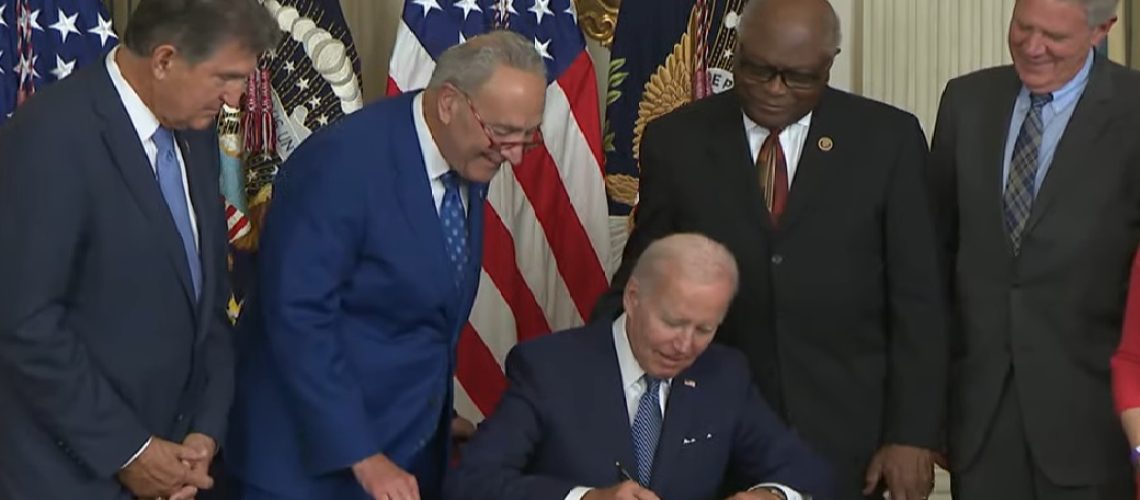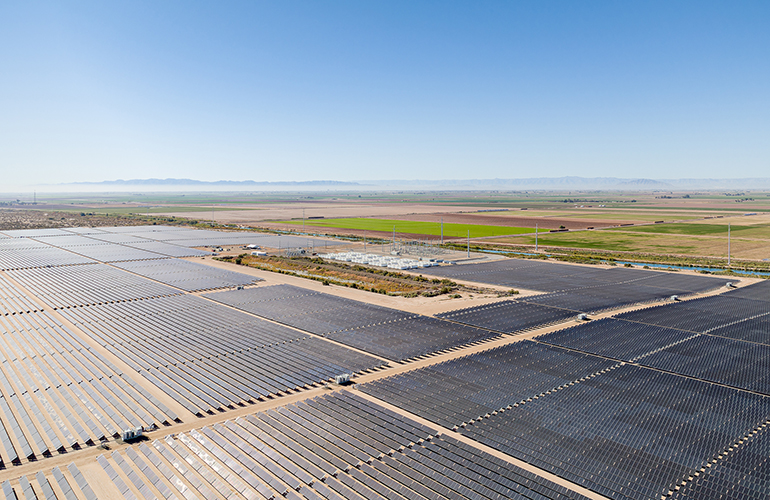On the first anniversary of the passage of the Inflation Reduction Act (IRA), the historic bill has already begun to stimulate the economy and move the U.S. toward a carbon-neutral future.
The massive energy, climate and tax bill includes $600 billion in spending, $370 billion of which is focused on supporting renewable energy buildout and climate resilience. The spending will be supported by closing tax loopholes on the wealthiest Americans and corporations. The legislation contains numerous provisions to support the U.S. solar industry, including a long-term extension of the federal investment tax credit, significant domestic manufacturing incentives, labor standards, production tax credits and more.
In the past twelve months, numerous industry experts have pontificated on just what the IRA will mean for the U.S. economy, the climate, supply chain security and more. The experts at the National Renewable Energy Lab, for example, expect that the IRA will increase clean energy in the range of 71% to 90% of total U.S. generation by 2030.
According to new analysis from the Solar Energy Industries Association (SEIA), in the year since the IRA went into effect, U.S. solar and storage companies have announced over $100 billion in private sector investments, with as many as 51 solar manufacturing facilities announced or expanded in the last year.
The impetus behind the growth in solar manufacturing are the production tax credits (PTC) within the IRA. Previously afforded to wind farms, PTCs now include solar for the first time. That clean-energy PTC will be available until the end of 2024 when it will become technology-neutral. Solar, wind, geothermal, biomass, hydropower, and other eligible projects will bank a tax credit of $0.003 per kilowatt-hour generated, with $0.015 paid to projects built by workers in receipt of a prevailing wage and that met apprenticeship requirements. A higher PTC, of $0.026/kWh, is available for projects built before an “act beginning construction deadline” which will occur 60 days after the Internal Revenue Service specifies its wage and apprenticeship requirements.
In recent months, pv magazine USA has reported on a plethora of manufacturing announcements across the PV supply chain, with the most recent being German manufacturer Siemens, which plans to open a string inverter factory in the U.S. where it plans to supply 800 MW annually to the U.S. utility-scale market.
While U.S.-made inverters are expected to provide only 7 GW of capacity, the capacity expectations of domestically made modules, cells, ingots and wafers are impressive. SEIA projects that by 2026, the U.S. will have over 17 times its current manufacturing capacity across the supply chain, or enough to supply a majority of solar projects expected to be built in the U.S.
The announcements include:
- 85 GW of module capacity
- 43 GW of cells
- 20 GW of silicon ingots and wafers
- 7 GW of inverter capacity
Among these announcements is Swiss-Germany company Meyer Burger, which will construct a 2 GW per year solar cell manufacturing facility in Colorado Springs, Colorado. The facility will be used to produce solar cells for its own solar module manufacturing facility in Arizona.
QCells also announced plans to manufacture across the supply chain including ingots, wafers, cells, modules and encapsulants to be made a new facility in Bartow County, Georgia, complementing its existing facility in Dalton, Georgia.
“The unprecedented surge in demand for American-made clean energy is a clear sign that the clean energy incentives enacted last year by Congress are working,” said SEIA president and CEO Abigail Ross Hopper.
Not only will domestic manufacturing ensure that U.S. clean energy investments stay in the U.S., but it will contribute to the economies of the manufacturing region. Many cities, states and counties a incentivizing solar firms to attract them to invest in their area because of the economic benefits. According to the National Association of Manufacturers, for every $1 spent on manufacturing, $2.60 is added to the economy.
Solar manufacturing facilities announced in the last year will employ more than 20,000 Americans. The nation’s solar manufacturing workforce is set to triple in size to over 100,000 jobs in the next decade, which is good news. The challenge, however, is in finding the workers. According to the recent National Solar Jobs Census from the Interstate Renewable Energy Council (IREC), the reality is that the tight labor market in the U.S. continues to create hiring challenges. The report notes that in 2022, 44% of solar industry employers said it was “very difficult” to find qualified applicants—the highest such percentage ever recorded in the Solar Jobs Census. The Inflation Reduction Act attempts to remedy the problem with new workforce-related requirements that address training, pay, diversity and job development in underserved areas.
Among the many benefits of the passage of the historic Inflation Reduction Act, in addition to securing a domestic supply chain, isthe decarbonization of the U.S. grid. IREC forecasts that total U.S. installations will multiply fivefold in the next 10 years, from 141 GW in 2022 to over 700 GW in 2033. The growth of emission-free solar energy will offset 459 million metric tons of CO2 annually by 2033, equivalent to roughly one-third of all power sector emissions in 2021.
While we look back at the opportunities presented by the IRA, we must also acknowledge the challenges that must be overcome as we build out a clean energy grid. Gregory Wetstone, president and CEO of the American Council on Renewable Energy (ACORE), noted that challenges including supply chain constraints, trade restrictions, permitting and interconnection queue delays, insufficient transmission capacity, and workforce shortages can delay deals, increased project costs, and more. “Today’s anniversary is one to celebrate, but we have work to do to realize the full potential of the new law and achieve the Biden administration’s ambitious clean energy goals. We must address these pivotal challenges to achieve the clean energy future that the American people want, and our scientists say we desperately need.”






